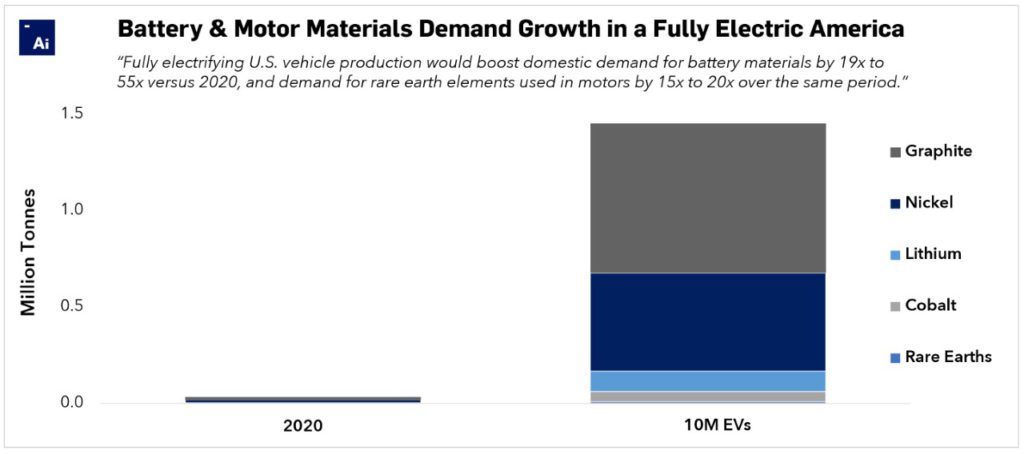
Batteries are being used in everything these days, as devices are increasingly mobile and cars begin to require energy storage. Power grids are slowly being converted for solar and wind generation, and infrastructure is being developed with electrification built into the plans. We could eventually see electrified roads that charge cars as they drive.
To make all of this possible, President Biden has announced an infrastructure, and EV plan, that would put electric vehicles and electrification of the economy at the forefront of economic priorities and a jobs creation strategy. To support these efforts, battery metals will be needed by the millions of tonnes, and the U.S. will need to look to allies and economic partners to fill the demand. Two of the most important partners in this venture could be Canada and Australia.
Biden’s Big Vision
The American plan outlines that processing should be done domestically, but due to supply chain constrictions and cost-analyses, the U.S. should look abroad for most supplies of EV metals and materials. There are significant barriers to this strategy that American mining companies have pointed out. Ultimately, U.S. miners believe that the government should promote mining domestically and boost jobs through the industry. Additionally, they note that countries like Chile and Australia – the two largest lithium producers – ship most of their product for processing into battery cathodes and other parts to Asia. To divert and change their supply chains to supply the U.S. would be unrealistic and extremely unlikely.
However, the U.S. still has a shortage to fill to meet future demand, as mining analysts are quick to note. They predict that the country may not be able to supply more than 30% of the overall lithium demand required to build EVs domestically by 2030. This view was seconded by Adamas Intelligence analysts in a recent review. With the country striving to meet climate goals that include half of all new automobile sales to be electric by 2030 and every car on the road to be electric by 2040, the mining industry will have its hands full for some time.
EV Batteries Set to Drive Huge Demand
Every year, approximately 10 million plug-in electric passenger vehicles and light trucks would need to be produced by 2030. This would grow battery capacity and motor power demand by 775-gigawatt hours, and 1,500 GW, respectively – every single year. Demand for raw materials would rise as well, far beyond what the U.S. could reasonably produce.

Metals and minerals like nickel, cobalt, copper, and lithium are all required for the battery production and many of the other components required for EVs. The U.S. hosts approximately 3% of known global nickel reserves, produces approximately 15% to 20% of the world’s Class 1 battery-grade nickel annually, and is the sixth-largest cobalt producer in the world. For the popular lithium-ion batteries used in EVs, all of these are essential and under-supplied right now. The energy-dense batteries that are likely to become more dense over time through investments in research and development continue to drive demand for nickel, cobalt, lithium, and more.
The U.S. Requires Stable, and Clean Mining Partners
Extraction is a complicated process, and with a growing focus on environmental, social, and governmental issues (ESG) at the forefront of the equation, mining companies are paying special attention to not just what they are mining, but how they are mining it. Canada in particular extracts all three of the mentioned minerals and metals above with a high degree of transparency and provenance, giving the country an advantage over other countries that may have looser regulations and enforcement.
For the U.S., to buy mined products from producers that did not mine in a safe or clean environment would be in opposition with the project’s overall goal of making the environment cleaner. To mine the materials necessary for the electrification of the economy in a clean way is a necessary element of this plan if it is to be done effectively. Canada and Australia also have stronger workers’ rights in effect and other jurisdictions with cobalt and nickel mining sometimes have issues with human rights as well.
Adamas Intelligence’s recent analysis reads, “In a fully electric America, it would need more than three times the nickel supply that Canada currently produces and 15 times its current cobalt supply annually.” The analysis goes on to say that although Australia – the world’s top lithium producer with 50% of global annual output – could benefit greatly from U.S. electrification, it is unlikely that the island nation would redirect exports from Asia. However, getting around this barrier is essential as the U.S. could buy all of Canada’s supply and still require much more.
Economic, Social, and Electric Goals Require Cooperation
The geo-political and economic alliance made between the G7 countries means that the partnerships for the common goals of electrification and clean-energy initiatives are fully aligned. It will be up to these friendly nations to come together to figure out how to meet those goals together while balancing their own electrification plans. While Canada might be able to supply a large chunk of the demand from the U.S., the northern neighbour’s own needs will have to be factored in as well. Canada has also set aggressive electrification targets along with Europe and Australia, and while U.S. demand is set to outstrip all of the other regions in the next ten years, these partners will need to work together to avoid supply vacuums and other issues as they all race toward the same targets.



 Follow us on Twitter
Follow us on Twitter Become our facebook fan
Become our facebook fan











Comments are closed.